New Mexico Together for Healthcare, a statewide, multiracial campaign of families and community organizations working together to strengthen healthcare access for New Mexico residents, applauded Gov. Michelle Lujan Grisham on Friday for signing House Bill 7 at a ceremony at Sierra Vista Hospital. HB 7 is critical legislation that will ensure sufficient and consistent funding for the Healthcare Affordability Fund.
“There are more than 200,000 New Mexicans without health insurance,” said Luz
Villescas, a healthcare community leader from Sunland Park. “With stable funding for
the Healthcare Affordability Fund, more New Mexico residents will have the opportunity
to access affordable health insurance.”
Created in 2021, the Healthcare Affordability Fund lowers costs for New Mexico
residents buying insurance through beWellNM and for small businesses buying
coverage through the marketplace. The fund also supports the development of
healthcare coverage initiatives for uninsured residents.
The fund has already had a significant impact on healthcare affordability by lowering
small-business premiums by 10 percent and providing $0-premium plans for Native
Americans earning less than three times the poverty line (less than $41,000 a year for
an individual and less than $70,000 a year for a family of three). Since the COVID-19
public health emergency ended, HAF has also helped individuals transition from
Medicaid to the Exchange by paying their first month’s premium.
“The Healthcare Affordability Fund is working,” said Adriann Barboa with Strong
Families New Mexico. “Lowering premiums, increasing access to coverage and
improving the well-being of thousands of New Mexico residents is an incredible success
story. By stabilizing revenue for the fund, New Mexico will continue to improve
healthcare outcomes and change lives.”
Despite the overwhelming positive impact of the Healthcare Affordability Fund, the
legislation that created the fund provided that 55 percent of the revenue generated by a
fee paid by insurance companies would go to the Fund with the remaining 45 percent
going to the General Fund for the first few fiscal years. In FY 25, however, the fund’s
share of the revenue was set to drop to 30 percent with 70 percent going to the General
Fund. Such a dramatic decrease in HAF funding, roughly $80 million, would have
hamstrung efforts to reduce healthcare costs and left many New Mexico residents
without access to the care they need.
Fortunately, HB 7, passed with bipartisan support in both the House and the Senate,
stabilizes HAF funding at the original levels with 55 percent going to HAF and 45
percent to the General Fund. The Legislature’s bipartisan support for this bill
underscores the value New Mexicans place on healthcare access.
“Everyone has the right to health care and preventative care,” said Kira Lotz with Casa
de Salud in Albuquerque. “When you take a holistic approach to health care and
medicine, everything from disease treatment to preventative measures really matters.
The Healthcare Affordability fund really encompasses this holistic approach to medicine
and ensures that everyone has access to health care.”
The signing of HB 7 aligns with New Mexico’s commitment to taking care of our families
and our neighbors. NMT4HC believes that in signing this bill Governor Lujan Grisham
has again demonstrated strong leadership in protecting the health and safety of New
Mexico residents.
“For many years I have seen and experienced what it is to live without health
insurance,” said Cecilia Piñon, a community organizer with Strong Families New
Mexico. “My father died working as a farm worker and never was able to have health
insurance. We all come from different backgrounds and our families experience different
health concerns. We all have a dream of raising healthy families in our beautiful state.
Support for the Healthcare Affordability Fund will allow New Mexico to continue its path
toward health coverage for everyone.”
Initially HB 7 eliminated the drop-off to 30 percent of revenue entirely, making the 55
percent distribution permanent effective immediately. However, the Legislative Finance
Committee’s FY 25 budget projection was already based on the assumption that the
General Fund’s share would increase to 70 percent in accordance with the original
legislation. To make sure there’s no impact on the FY 25 budget, the House
Appropriations and Finance Committee amended HB 7 so the Healthcare Affordability
Fund’s share drops to 30 percent for the upcoming fiscal year (FY 25) only and goes
back to 55 percent for all subsequent fiscal years. After the one-time dip in funding in
FY 25, the fund is expected to generate $183 million for healthcare access in FY 26.
In 2020 Congress repealed a federal fee on insurance companies that had been
imposed by the Affordable Care Act. The 2021 legislation that established the
Healthcare Affordability Fund shifted the fee so that the state can now collect it.
Because around 75 percent of the revenue generated comes from Medicaid MCOs,
most of the fee’s costs are paid by the federal government. (Source: OSI’s FIR Analysis
for the 2021 bill)

